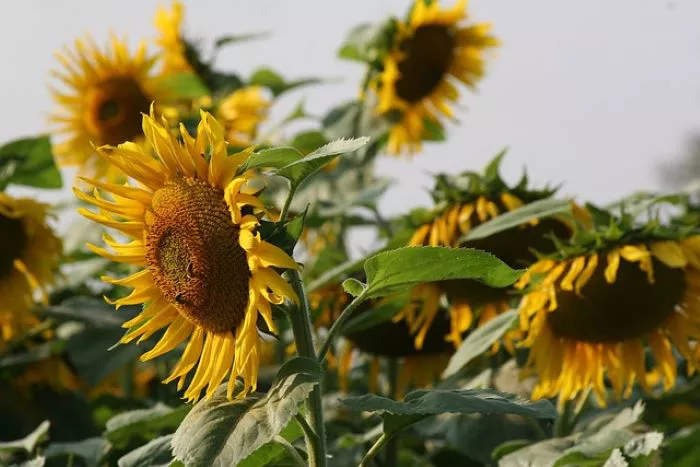Sunflowers are among the most recognizable and beloved flowers in the world. Their bright yellow petals and large heads turn towards the sun, creating a vibrant display in gardens and fields. Among the many varieties of sunflowers, one stands out for its impressive size. This article will explore the biggest type of sunflower, its characteristics, cultivation, and significance.
Introduction to Sunflowers
Sunflowers belong to the genus Helianthus, which includes about 70 species. They are native to the Americas and have been cultivated for thousands of years for their seeds, oil, and ornamental value. Sunflowers are known for their unique ability to track the sun’s movement across the sky, a phenomenon called heliotropism. This characteristic is most prominent in young sunflowers, which tend to orient their heads toward the sun during the day.
The Giant Sunflower
The biggest type of sunflower is known as the Giant Sunflower, specifically the variety called Helianthus annuus. This type is famous for its enormous flower heads and tall stature. Giant sunflowers can grow to impressive heights, often exceeding 10 feet. Some exceptional specimens have been recorded at over 16 feet tall, making them a remarkable sight in any garden or field.
Characteristics of the Giant Sunflower
Giant sunflowers are characterized by several distinct features
Height: As mentioned, these sunflowers can reach heights of up to 16 feet or more. The average height for most giant sunflowers is around 10 to 12 feet.
Flower Size: The flower heads of giant sunflowers can measure over 12 inches in diameter. Some varieties produce heads that are even larger, making them a striking focal point in any landscape.
Sturdy Stems: To support their massive size, giant sunflowers have thick, sturdy stems. These stems can be several inches in diameter and are often covered in coarse hairs.
Seed Production: Giant sunflowers are known for their prolific seed production. A single flower head can contain thousands of seeds, which are a valuable food source for birds and humans alike.
Color Variations: While most giant sunflowers are bright yellow, some cultivars may produce orange or red flowers. These variations add to the visual appeal of the plant.
Cultivation of Giant Sunflowers
Growing giant sunflowers is a rewarding experience for gardeners. Here are some essential steps for successful cultivation
Choosing the Right Location: Giant sunflowers thrive in full sun. Select a location that receives at least six to eight hours of sunlight each day.
Soil Preparation: Sunflowers prefer well-draining soil that is rich in organic matter. Before planting, amend the soil with compost or well-rotted manure to improve fertility.
Planting Seeds: Sow sunflower seeds directly in the garden after the last frost date. Plant seeds about 1 inch deep and space them 12 to 18 inches apart. This spacing allows for adequate air circulation and sunlight exposure.
Watering: Sunflowers need regular watering, especially during dry spells. Water deeply to encourage strong root development. Avoid overhead watering to minimize the risk of fungal diseases.
Fertilization: Fertilize giant sunflowers with a balanced fertilizer during the growing season. This will promote healthy growth and abundant flower production.
Supporting Tall Plants: Due to their height, giant sunflowers may require support. Use stakes or trellises to prevent them from bending or breaking in strong winds.
Pest and Disease Management: Keep an eye out for common pests such as aphids and sunflower beetles. Use organic pest control methods to manage infestations. Proper spacing and air circulation can help prevent diseases.
Uses of Giant Sunflowers
Giant sunflowers have various uses that extend beyond their ornamental value
Culinary Uses: The seeds of giant sunflowers are edible and nutritious. They can be eaten raw, roasted, or used to make sunflower oil. Sunflower seeds are rich in healthy fats, protein, and vitamins.
Wildlife Habitat: Sunflower heads attract a variety of wildlife, including birds and insects. The seeds provide a food source for many species, making them an excellent addition to wildlife gardens.
Cut Flowers: Giant sunflowers make stunning cut flowers. Their large heads and vibrant colors add a cheerful touch to floral arrangements.
Biodiversity: Planting sunflowers can enhance biodiversity in gardens. They attract pollinators such as bees and butterflies, which are essential for the health of ecosystems.
Cultural Significance of Sunflowers
Sunflowers hold cultural significance in many societies. They are often associated with warmth, positivity, and happiness. In some cultures, sunflowers symbolize loyalty and adoration. The flower has also been used in art and literature to convey themes of beauty and nature.
In addition to their aesthetic and symbolic value, sunflowers have practical applications. They are used in crop rotation to improve soil health and reduce pests. Sunflower oil is a popular cooking oil, known for its light flavor and high smoke point.
Conclusion
The giant sunflower is a remarkable plant known for its impressive size and beauty. With heights exceeding 10 feet and flower heads measuring over a foot in diameter, it is a stunning addition to any garden. Understanding how to cultivate and care for giant sunflowers can lead to a rewarding gardening experience. Their culinary uses, wildlife benefits, and cultural significance further enhance their appeal. Whether grown for their beauty or practical applications, giant sunflowers continue to capture the hearts of gardeners and nature lovers alike.


